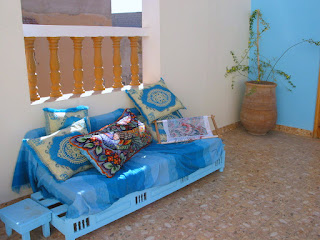It is light here about 7.00 by 8.00 the wholesale and beastmarkets are in full swing and the fish fryers are just staring up trade. The vegetable market is still partly setting up. If you go into town it is dead the shopkeepers and stallholders there not getting going until about 10.00, but later in the day the town comes alive with many more street traders than a weekday. The Sunday market is basically for small farmers from all over the Souss and this part of the Atlas to sell their produce. They will have left their villages well before dawn and need to sell before they can buy which accounts for the timetable and the need for a fish breakfast.
 |
| Taroudant sunday market |
 |
| Hay for sale Taroudant Sunday market |
 |
| A very small part of a carrot wholesalers |
 |
| Vegetable for sale Taroudant Sunday market |
















































